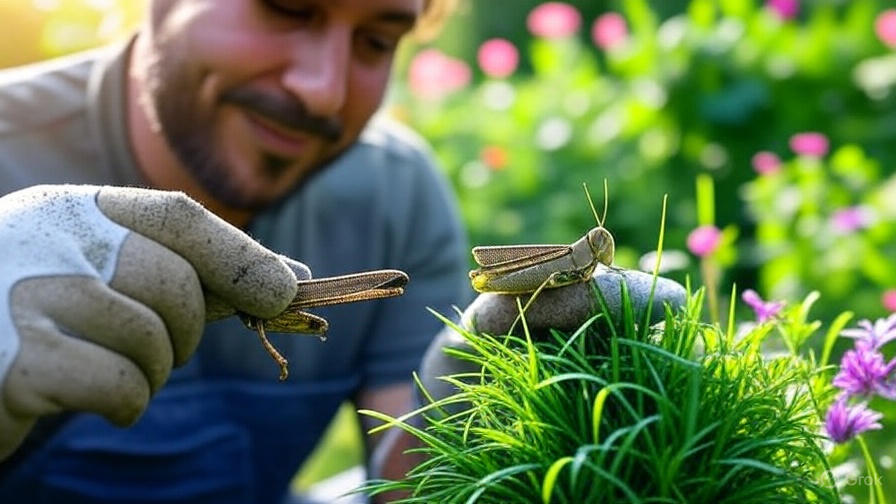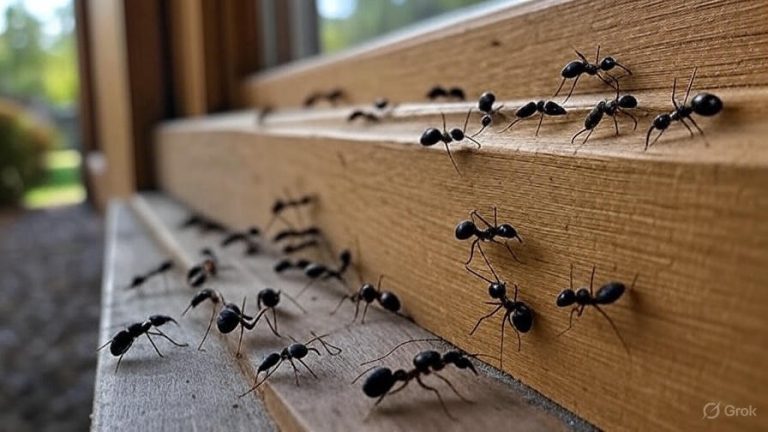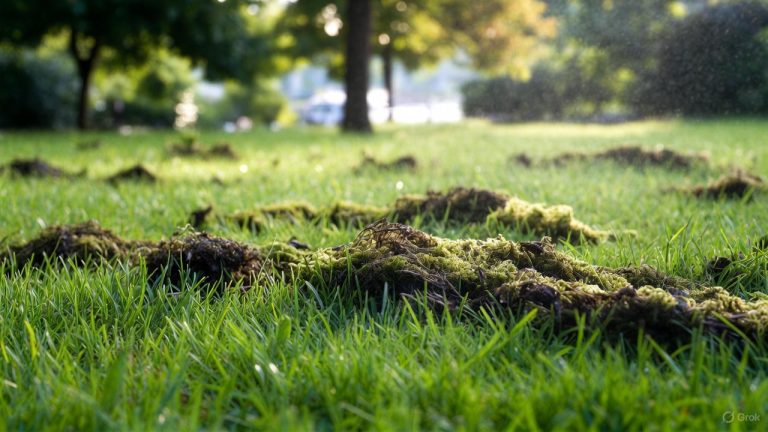How to Rid Your Garden of Grasshoppers?
Grasshoppers can transform a thriving garden into a barren landscape in just days. These voracious insects consume up to half their body weight in vegetation daily, making them one of the most destructive garden pests. While a few grasshoppers might seem harmless, an infestation can devastate your precious plants, vegetables, and flowers.
This comprehensive guide reveals proven methods to eliminate grasshoppers from your garden naturally and effectively. From prevention strategies to emergency control measures, you’ll discover practical solutions that protect your garden without harming beneficial insects or the environment.
Recognizing Grasshopper Problems in Your Garden
Before launching into control methods, you need to identify grasshopper activity. These insects leave telltale signs that distinguish them from other garden pests. Large, irregular holes in leaves signal grasshopper feeding, as they chew through plant tissue rather than creating neat, round holes like other insects.
Grasshoppers prefer young, tender vegetation and target specific plants. They gravitate toward grasses, lettuce, carrots, beans, corn, flowers, and onions while typically avoiding tomato leaves, squash, and peas. This selective feeding pattern helps you identify grasshopper damage versus other pest problems.
The timing of damage also provides clues. Grasshopper problems peak during hot, dry weather when their populations explode. Late summer often brings the worst infestations as young grasshoppers mature and their appetites increase dramatically.
Natural Prevention: Your First Line of Defense
Prevention beats cure when dealing with grasshopper infestations. Creating an environment that discourages these pests saves time, money, and plants in the long run. Smart garden planning forms the foundation of grasshopper prevention.
Strategic Plant Selection
Certain plants naturally repel grasshoppers while others attract them like magnets. Building your garden around grasshopper-resistant plants creates a natural barrier against infestations. Herbs like cilantro, calendula, and sweet clover contain compounds that grasshoppers find unpalatable.
Diversifying your plant varieties also reduces grasshopper damage. When you plant only their favorite foods, you create an all-you-can-eat buffet. Mixed plantings force grasshoppers to work harder for meals and reduce overall damage to any single crop.
Soil Management Techniques
Healthy soil supports plants that can better withstand pest pressure. Well-drained, nutrient-rich soil produces vigorous plants that recover quickly from minor grasshopper damage. Regular composting and organic matter additions improve soil structure and plant resilience.
Tilling your garden soil twice yearly disrupts grasshopper egg-laying cycles. Fall and spring tilling can help prevent grasshoppers from laying eggs, breaking their reproductive cycle before problems begin. This simple practice significantly reduces next season’s grasshopper populations.
Garden Layout and Design
Your garden’s physical layout influences grasshopper activity. These insects prefer open areas with easy access to multiple food sources. Creating barriers and obstacles makes your garden less attractive to migrating grasshoppers.
Border plantings of grasshopper-resistant species create a protective perimeter around vulnerable crops. This living fence forces grasshoppers to encounter deterrent plants before reaching your prized vegetables and flowers.
Biological Control Methods: Working with Nature
Nature provides powerful allies in the fight against grasshoppers. Biological control methods harness natural predators and diseases to manage grasshopper populations sustainably. These approaches take time to establish but provide long-term protection.
Encouraging Natural Predators
Birds, spiders, and beneficial insects naturally control grasshopper populations. Creating habitat for these predators transforms your garden into a balanced ecosystem where grasshoppers face constant pressure from multiple enemies.
Installing bird houses and providing water sources attracts insectivorous birds that consume large numbers of grasshoppers daily. Chickens and guinea fowl excel at grasshopper control if local regulations permit backyard poultry. These birds actively hunt grasshoppers while providing eggs and entertainment.
Beneficial insects like praying mantises, ground beetles, and spiders prey on grasshoppers throughout their life cycle. Avoiding broad-spectrum pesticides preserves these natural predators and maintains ecological balance in your garden.
Microbial Insecticides
Biological insecticides contain naturally occurring pathogens that specifically target grasshoppers without harming beneficial insects. Nosema locustae represents the most effective biological control agent for grasshoppers.
This microscopic parasite infects grasshoppers when they consume treated bait. Infected grasshoppers become sluggish, eat less, and eventually die while spreading the disease to other grasshoppers. The effects build slowly but persist for years in the environment.
Apply biological baits to grasshopper feeding areas and egg-laying sites in early spring when young grasshoppers first emerge. The slow-acting nature requires patience, but results improve each year as the pathogen establishes in local grasshopper populations.
Physical Barriers and Mechanical Control
Physical exclusion methods provide immediate protection for valuable plants. These techniques work best for small gardens or high-value crops that justify the labor investment. Row covers and netting create impenetrable barriers against grasshoppers.
Row Covers and Garden Fabric
Harvest-Guard row covers can be used to cover and protect small garden areas from grasshopper damage. Lightweight fabrics allow sunlight and water penetration while blocking insect access. This method works especially well for protecting seedlings and young plants during their most vulnerable growth stages.
Secure row covers tightly to prevent grasshoppers from crawling underneath. Remove covers periodically for weeding and harvesting, then replace immediately. The temporary inconvenience pays dividends in crop protection during peak grasshopper season.
Hand Collection and Removal
Small grasshopper populations respond well to manual removal. If you have a small amount of grasshoppers, you can hand pick and squash them before they reproduce and multiply. Early morning collection works best when cool temperatures make grasshoppers sluggish and easier to catch.
Shake plants gently to dislodge hiding grasshoppers into containers filled with soapy water. This drowns captured insects while preventing their escape. Regular hand collection reduces local populations and prevents egg-laying in your garden.
Organic Spray Solutions and Natural Repellents
Organic sprays provide quick knockdown of grasshopper populations without synthetic chemical residues. These solutions work through contact action or by making plants unpalatable to feeding grasshoppers. Multiple applications may be necessary for complete control.
Neem Oil Applications
Neem oil directly on nymphs or your plants provides effective grasshopper control through multiple mechanisms. This botanical pesticide disrupts insect development while deterring feeding on treated plants. Neem oil breaks down quickly in sunlight, reducing environmental persistence.
Apply neem oil sprays in early morning or late evening to prevent leaf burn from sun exposure. Thorough coverage of plant surfaces ensures grasshoppers contact the treatment during feeding. Repeat applications every 7-10 days maintain protection throughout peak season.
Soap and Oil Sprays
Homemade insecticidal soaps suffocate grasshoppers on contact while washing away their protective waxy coating. Mix 2 tablespoons of liquid dish soap per gallon of water for an effective spray solution. Add 1 tablespoon of vegetable oil to improve spray adhesion and effectiveness.
Test soap sprays on a few leaves before widespread application to avoid plant damage. Some plants show sensitivity to soap solutions, especially during hot weather. Rinse plants with clean water if soap residue causes leaf spotting or burning.
Garlic and Hot Pepper Sprays
Strong-smelling botanical sprays repel grasshoppers through taste and odor deterrence. Blend 3-4 garlic cloves and 2 hot peppers with 2 cups of water, then strain the mixture for spraying. These repellent sprays require frequent reapplication but provide safe, non-toxic protection.
Essential oils like peppermint, rosemary, and sage can enhance homemade repellent sprays. Add 10-15 drops of essential oil per quart of spray solution for increased effectiveness. These aromatic compounds mask plant odors that attract grasshoppers.
Trap and Bait Strategies
Trapping removes grasshoppers from your garden while monitoring population levels. Successful trapping requires understanding grasshopper behavior and placing traps in strategic locations. Combine multiple trap types for maximum effectiveness.
Molasses Trap Construction
Sweet baits attract grasshoppers into lethal traps that reduce local populations. The sugar molasses will attract the insects, which will become trapped in the water, providing an effective control method. Fill shallow containers with water and add 1 part molasses to 10 parts water.
Position molasses traps around garden perimeters and near heavily damaged plants. Grasshoppers jump into containers while seeking the sweet bait and drown in the water. Empty and refill traps weekly or when grasshopper bodies accumulate.
Cardboard and Board Traps
Simple shelter traps exploit grasshopper behavior patterns. These insects seek shelter under objects during hot midday temperatures. Place boards, cardboard sheets, or other flat materials throughout your garden as grasshopper hiding spots.
Check traps daily during peak heat when grasshoppers congregate underneath. Quickly flip traps and capture or kill hidden grasshoppers before they escape. This method works best when combined with other control strategies for comprehensive management.
Advanced Control Techniques for Severe Infestations
Severe grasshopper infestations may require intensive control measures beyond basic prevention and organic methods. These advanced techniques address established populations that threaten entire gardens or crops. Timing becomes critical for maximum effectiveness.
Targeted Chemical Applications
When organic methods prove insufficient, selective insecticides provide rapid population reduction. Choose products specifically labeled for grasshopper control with minimal impact on beneficial insects. Focus applications on grasshopper congregating areas rather than broad garden treatment.
A homeowner can slow or block their movement by treating all vegetation in a band or border perimeter around the yard and/or garden with an insecticide, creating a protective barrier. This perimeter treatment intercepts migrating grasshoppers before they reach garden plants.
Apply treatments during early morning or evening when grasshoppers are most active and beneficial insects are less likely to contact sprayed surfaces. Follow label directions precisely for application rates and safety precautions.
Professional Consultation
Persistent grasshopper problems may benefit from professional pest management expertise. Extension agents and licensed applicators can identify specific grasshopper species and recommend targeted control strategies. Professional treatments may access more effective products unavailable to homeowners.
Document grasshopper damage with photos and notes about timing, affected plants, and control attempts before consulting professionals. This information helps experts develop customized management plans for your specific situation.
Seasonal Timing for Maximum Effectiveness
Grasshopper control success depends heavily on proper timing. These insects follow predictable life cycles that create opportunities for intervention at vulnerable stages. Early action prevents small problems from becoming major infestations.
Spring Prevention Measures
Spring preparation sets the stage for season-long grasshopper management. To be successful these need to be applied to developing stages of grasshoppers and concentrated at sites where egg laying occurs, making early intervention crucial. Target treatments toward young grasshoppers before they develop strong flight muscles.
Cultivate garden soil in early spring to destroy overwintering eggs before they hatch. Apply biological controls like Nosema locustae when soil temperatures reach 60°F and young grasshoppers begin emerging. This timing ensures maximum pathogen uptake by vulnerable nymphs.
Monitor weather patterns since both the fungus disease and nematode parasite are favored by wet weather. Cool, moist springs provide ideal conditions for biological control establishment while hot, dry conditions favor grasshopper survival and reproduction.
Summer Management Strategies
Summer brings peak grasshopper activity as adults reach maturity and maximum feeding capacity. Focus control efforts on protecting high-value crops and preventing egg-laying in garden areas. Maintain consistent monitoring and intervention throughout the growing season.
Apply organic sprays and repellents every 10-14 days during peak activity periods. Increase application frequency during hot, dry weather when grasshopper populations explode. Combine multiple control methods for synergistic effects against established populations.
Fall Cleanup and Preparation
Fall cleanup removes grasshopper habitat and egg-laying sites for next year’s prevention. Remove plant debris, tall grasses, and weedy areas where grasshoppers overwinter as eggs. Deep tillage in late fall destroys egg masses in soil.
Plant cover crops that grasshoppers find unpalatable to maintain soil protection while discouraging pest establishment. Plan next year’s garden layout to incorporate lessons learned from this season’s grasshopper challenges.
Long-term Garden Management for Grasshopper Prevention
Sustainable grasshopper management requires integrating multiple strategies into your overall garden management plan. This holistic approach addresses root causes rather than just treating symptoms. Long-term success comes from creating an environment that naturally suppresses grasshopper populations.
Companion Planting Systems
Strategic plant combinations create natural grasshopper deterrence throughout your garden. Interplant susceptible crops with grasshopper-resistant species to reduce pest concentration and damage. Aromatic herbs scattered throughout vegetable beds provide ongoing protection.
Establish permanent plantings of grasshopper-deterrent plants around garden borders. These living barriers become more effective each year as they mature and spread. Native plants often provide the best long-term deterrence while supporting beneficial insects.
Ecosystem Development
Mature gardens with diverse plant communities naturally resist grasshopper infestations better than simple monocultures. Encourage beneficial insect populations through habitat diversity and avoiding disruptive practices. This biological diversity creates multiple checks on grasshopper population growth.
Maintain some wild areas near your garden to support predator populations. These refuges provide overwintering sites for beneficial insects and nesting areas for insectivorous birds. The investment in habitat pays dividends through natural pest suppression.
Monitoring and Early Detection Systems
Regular monitoring prevents small grasshopper problems from becoming devastating infestations. Develop systematic observation routines that catch pest buildup before damage becomes severe. Early detection allows for targeted interventions when control methods are most effective.
Weekly Garden Inspections
Schedule weekly walks through your garden specifically to monitor for grasshopper activity. Look for feeding damage, insect sightings, and environmental conditions that favor population growth. Document observations to track trends and evaluate control effectiveness.
Focus monitoring efforts on grasshopper-preferred plants and areas with previous infestations. These hotspots typically show the first signs of new activity. Quick response to initial detections prevents rapid population multiplication.
Damage Assessment Techniques
Learn to distinguish grasshopper damage from other pest problems through careful observation. Grasshopper feeding creates large, irregular holes along leaf margins while other insects create different damage patterns. Accurate identification ensures appropriate control responses.
Photograph damage patterns and insect sightings to build a reference library for future identification. These records help improve your recognition skills and provide documentation for consulting with extension agents or pest management professionals.
Conclusion: Your Path to a Grasshopper-Free Garden
Success in grasshopper control comes from combining multiple strategies into a comprehensive management approach. Prevention through smart plant selection and garden design provides the foundation, while biological controls offer sustainable long-term suppression. Physical barriers and organic sprays provide immediate protection when needed.
The key lies in early intervention and consistent monitoring. Small grasshopper populations are much easier to control than established infestations. Regular garden inspections and prompt response to initial sightings prevent minor problems from becoming major disasters.
Remember that grasshopper management is an ongoing process rather than a one-time treatment. Weather patterns, neighboring land use, and garden changes all influence grasshopper pressure from year to year. Adaptability and persistence will ultimately reward you with a thriving, productive garden that can withstand periodic grasshopper challenges.
Start implementing these strategies gradually, beginning with prevention measures and monitoring systems. Build upon successful techniques while learning from any setbacks. Your garden will become increasingly resistant to grasshopper damage as you refine your management approach and develop local expertise in pest control.
With patience and consistent effort, you can transform your grasshopper-plagued garden into a productive paradise that provides bountiful harvests year after year. The satisfaction of protecting your plants through natural, sustainable methods makes the effort worthwhile for any dedicated gardener.







